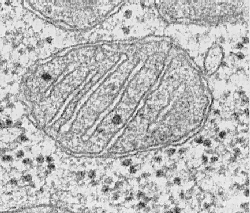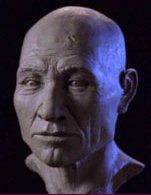Midi-Chlorians:
Physiology, Physics, and the Force
By Chris Knight
Introduction
What are Midi-Chlorians?
Midi-Chlorians and the Force
Force in the Family
Time, Space, and the Force
A Final, Force-ful Exit
Concluding Remarks
What Are Midi-Chlorians?
Midi-chlorians, as explained by the creator of Star Wars, George Lucas:
"Midi-chlorians are a loose depiction
of mitochondria, which are necessary components for cells to divide. They
probably had something--which will come out someday--to do with the
beginnings of life and how one cell decided to become two cells with a little
help from this other little creature who came in, without whom life couldn't
exist. And it's really a way of saying we have hundreds of little creatures
who live on us, and without them, we all would die. There wouldn't be any
life. They are necessary for us; we are necessary for them. Using them in
the metaphor, saying society is the same way, says we all must get along
with each other."
If Lucas wanted to further the theme of symbiosis between life and the Force,
he could not have found a more apt illustration than with mitochondria. Not only
are mitochondria required for cell division, they're required for EVERYTHING in a cell!
An analogous structure was needed between cells and the Force, and midi-chlorians
fill that need. So perhaps we should look at the fact behind the fiction...
Here is an image from an electron microscope of a mitochondrion:

Mitochondria are an essential part of all living cells. They convert the nutrients
(primarily carbohydrates and fatty acids) into adenosine triphosphate or ATP, the
"energy currency" that your cells - and your entire body - operate on. In animals and
humans, food consumed is broken down by the digestive system into its component substances,
which are dispersed throughout the body by circulation. These substances osmose through
cellular membranes and are converted as needed by the mitochondria into ATP. When energy
is required by the cell, it's the ATP molecule's breakdown into adenosine diphosphate (ADP)
that provides that energy, much like the internal combustion engine in your car. It also
produces waste product... namely, the carbon dioxide that you exhale with each breath.
With plants, the nutrients are taken from the soil by the root system and transported to
the leaves, where chloroplasts in leaf cells take the sun's light energy and convert that
into stored chemical energy, which is then used by the mitochondria. With plants, the
production of energy is reversed from animals, with a benevolent "waste product": breathable
oxygen. Animals (and humans) produce carbon dioxide for the plants, and plants produce
oxygen for us... symbiosis on a global scale.
Mitochondria rank as the most unusual of the cell's organelles: the elements of the
cell that are to it what your organs are to your body. They are the smallest, only being
studied by higher-powered microscopes. They are among the most numerous: thousands may be
crammed into the cell of heart tissue. Other organelles include ribosomes (used in protein
production), endoplasmic reticulum (the cellular transport system), centrioles (utilized in
cell division) and others, especially the nucleus. The nucleus is the "brain" of the cell.
And within it, usually bundled in pairs of chromosomes, is the molecule DNA: the master
code of an organism's being. It is the DNA that encodes protein composition in a complex
process that ultimately decides the form and function of an organism entire.
But the nucleus isn't the only place in a cell that DNA is found... mitochondria have
it too! And mitochondrial DNA has become a useful tool in fields ranging from cellular
biology to some branches of archaeology. When a child is conceived, he or she receives
mitochondria primarily from the mother, and this matrilineal passing of mitochondrial DNA,
which generally stays the same from one generation to the next, has been used to trace
migration and inter-marriage patterns. Recently the "Kennewick Man" skeleton found in
Washington state was to be subjected to mitochondrial DNA analysis to determine his origin:
speculation on this 9,000 year-old gentleman has him as everything from Ainu, the original
inhabitants of the islands of Japan, to Caucasian. Because of the age and location of the
skeleton, local Native Americans believe that Kennewick Man must be American Indian and are
against testing his mitochondrial DNA. As of this writing the issue is still unresolved.

Mitochondrial Mayhem: Kennewick Man
Most organelles are formed during mitosis or by "budding off" from the nucleus.
Not so mitochondria: with their own DNA, they replicate on their own... another hallmark
of independent life. But a mitochondrion is far from being a "cell within the cell". It
has been theorized that mitochondria began as simple bacteria which, engulfed by more
complex cells, began producing energy for the cell in symbiosis. But some scientists
point out problems with this classification: mitochondria have too specialized an internal
structure when compared with true bacteria. And if the cell is so dependent upon
mitochondria for metabolism, how did cells survive before the introduction of mitochondria?
Like so much else of science currently, the question is in a state of flux, brought
on by new theories and particularly new mathematics. Scientists know these things
happen, just now how exactly... yet. There are some gray areas that might not even be
resolved in the lifetime of our grandchildren. Scientific philosophy is now closely following
scientific fact in terms of importance.
All of which begs the question: mitochondria are part of microscopic life, but are they
true microscopic life-forms? And in our study, should the midi-chlorians of Star
Wars be considered true life-forms separate from their cells?
Science has never fully defined the microscopic limit of life. A cell is considered
the basic unit of carbon-based life (the only kind we know of so far), but what about a
virus? Viruses have no cells, only a protein sheathe protecting a core of DNA or RNA.
They have nothing of metabolism, but they do reproduce by "invading" real cells and
converting them into "virus factories", churning out more viruses and killing the cell.
They can be "killed", by high temperature or chemicals, but usually by an organism's immune
system (such as the lymphocytes and other white corpuscles that circulate in the blood
stream). But are our cells defeating a real living enemy, or merely engulfing protein
structures? To add to the confusion, in the last several years we have learned of
prions: bits of protein often smaller than a virus. Smaller, but no less dangerous,
prions are responsible for the "mad cow disease" that has plagued Europe recently, as well
as other illnesses. Prion-caused disease is proving to be remarkably tough to fight,
even moreso than those caused by viruses. Because of their makeup and effect on larger
organisms, should prions then be considered alive?
Mid-way between cells and viruses, there are cell organelles. Curiously,
organelles have never been considered to be autonomous living entities, because on their
own they cannot survive. Take endoplasmic reticulum - the cell's "transport system" - out
of the cell membrane, and all you have is a miniscule mess. Pluck out the nucleus and the
cell dies. What about mitochondria? Our cells couldn't survive without them, and they're
worthless without our cells. The same can be said for the nucleus... is that a "symbiont lifeform"
now, or do we give mitochondria more legitimacy because of its DNA?
Qui-Gon Jinn spoke of midi-chlorians residing in all living cells: the classic definition
of an organelle. Do we classify it as a separate life-form just because it's connected to
the Force... and why would such a tiny thing be needed for the Force, anyway?!
Here's the paradox: if midi-chlorians are a microscopic life-form, and if life couldn't
exist without them, then where did midi-chlorians come from? How did they become part
of "all" cells? How did life exist before their coming into being? Qui-Gon tells
Anakin that without midi-chlorians, life could not exist. The problem with that statement
is that life flourishes across the galaxy on millions of worlds in the Star Wars saga, all
of which possess midi-chlorians. Did midi-chlorians arise spontaneously on ALL worlds
then, "infecting" every lifeform? That would be a statistical improbability that most
science-fiction would avoid. How did one lifeform come about in precisely the same way
on planets so wildly different? And even given the miracle of hyperspace, it would have
taken thousands of years for midi-chlorians to have spread from one point of origin
to all known life... a period of time that all life would have been dead long before because
they lacked midi-chlorians. How would life arise without them?
Then again, we might be headed entirely in the "wrong" direction if we're
looking to mitochondria to
answer our questions about midi-chlorians. Despite all the knowledge we've gained on cells,
there are some things about them that we still do not understand. There is some evidence to
support the existence of "micro-bacteria" on a scale with the mitochondria. And some kinds of
microscopy used in studying living tissue have examined particles in human blood, the function
of which are still unknown! Might these be our "midi-chlorians"?
Whatever they might be, Qui-Gon's statement to Anakin implies that midi-chlorians are
ubiquitous to life. Obi-Wan explained to Luke that the Force was created by all living
things. Between these two facts, a theory lends itself. What if, instead of midi-chlorians
create sensitivity to the Force, the Force creates midi-chlorians?
Continued next page
Concepts in these pages are derived from
material created by Lucasfilm Ltd. and George Lucas. While these pages discuss Star Wars, they
are NOT to be considered "canon". This is merely a theory. As for the
true nature of midi-chlorians, as Mark Hamill once said, "only George knows."
Most of the ideas presented here are my original thoughts about midi-chlorians
to the best of my knowledge but some, such as theoretical physics and Kirlian photography,
are in the province of those who discovered them. Otherwise,
the layout, structure, and interpretation in these pages
is Copyright ? 2000 Chris Knight and TheForce.net.
Got questions? Comments? Suggestions? Think Chris has WAY too much time on his hands? Let us know!

